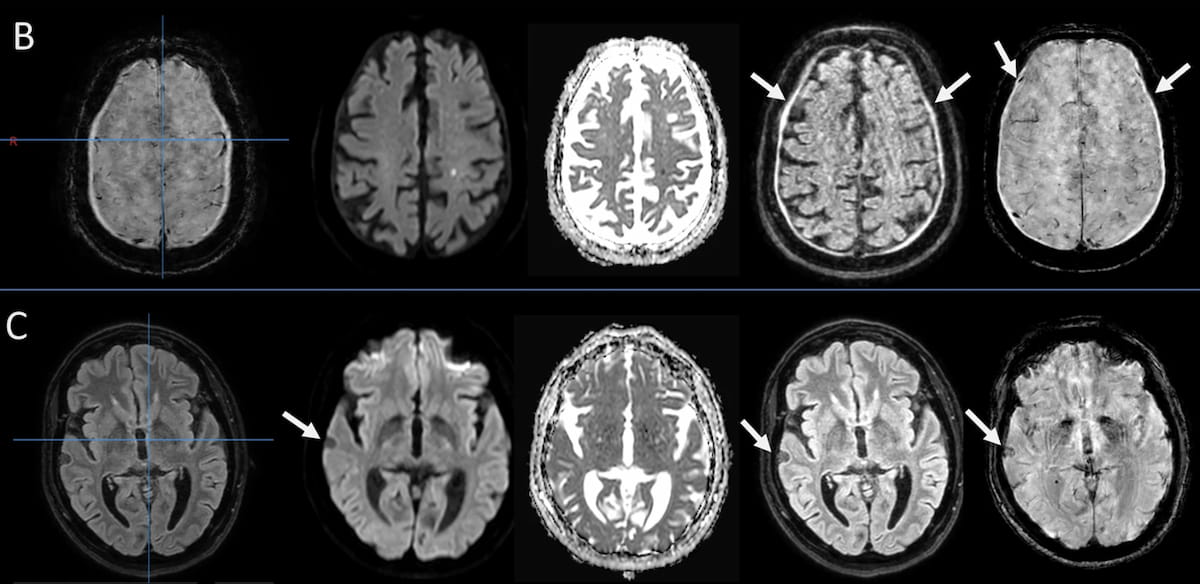New research demonstrates that advancing age and limb motor symptoms in patients with suspected stroke are associated with increased brain magnetic resonance imaging (MRI) motion artifacts that can reduce accuracy in detecting hemorrhagic lesions.
For the retrospective study, recently published in European Radiology, researchers examined brain MRI data from 775 adult patients (median age of 68) with suspected stroke. The study authors noted 216 cases of acute ischemic lesions, 12 patients with hemorrhagic lesions and 20 cases involving space-occupying lesions.
The researchers found that motion artifacts on brain MRI occurred in 57 patients (7.4 percent). A multivariable analysis determined that advancing age was associated with an odds ratio (OR) per decade of 1.61 for the presence of motion artifacts. Patients with limb motor symptoms had more the double the likelihood of motion artifacts (OR 2.36) on brain MRI, according to the study authors.
Here are a couple of examples of motion artifacts in MRI scans and false negative predictions with AI (left column). For the top images (B), the studied AI tool overlooked bilateral hygromas/subdural hematomas in an 83-year-old man with right-sided facial palsy and hemiparesis. For the bottom images (C), AI did not detect a small right-sided extra-axial tumor in a 66-year-old woman with aphasia. (Images courtesy of European Radiology.)
While researchers did not see a significant impact of motion artifacts on the detection of ischemic and space-occupying lesions, they noted a 21 percent reduction in artificial intelligence (AI) accuracy and a 7 percent reduction in radiologist accuracy for detecting hemorrhagic lesions.
“Our study indicated that motion artifacts were independently associated with higher patient age and motor symptoms. Motion artifacts were associated with lower diagnostic test accuracy and specificity for hemorrhage detection, and they explained up to one-fifth of the incorrect AI hemorrhage predictions,” wrote lead study author Christian Hedeager Krag, M.D., who is affiliated with the Department of Radiology at the University Hospital Copenhagen-Herlev and Gentofte in Copenhagen, Denmark, and colleagues.
Three Key Takeaways
- Advancing age and limb motor symptoms increase motion artifacts.
Patients with suspected stroke who are older or have limb motor symptoms are at significantly higher risk of MRI motion artifacts, which can impair diagnostic accuracy. - Motion artifacts may reduce hemorrhage detection accuracy.
Motion artifacts were linked to a 21 percent reduction in AI diagnostic accuracy and a 7 percent reduction in radiologist accuracy for detecting hemorrhagic lesions, though they did not significantly affect ischemic or space-occupying lesion detection. - Protocol adjustments may help minimize artifacts. Patients at higher risk for motion artifacts may benefit from tailored MRI protocols, such as shorter sequence acquisitions or the application of deep learning-based artifact reduction techniques.
The researchers noted longer mean sequence acquisition (92.3 seconds vs. 91.9 seconds) in patients with motion artifacts. They also found that 76 percent of patients with motion artifacts had 3D MRI sequences and noted a 21 percent higher incidence of gradient recalled (GR) susceptibility-weighted imaging (SWI)/T2 sequences among patients with motion artifacts (53 percent vs. 32 percent).
“Patients with a high predicted risk of motion artifacts could be scheduled for a specific protocol with shorter sequences and deep learning artifact reduction to minimize motion artifacts,” posited Krag and colleagues.
(Editor’s note: For related content, see “Can Abbreviated MRI Have an Impact in Neuroimaging?,” “Could Deep Learning Offer Quicker Acute Stroke Detection on Brain MRI Without the Need for T2WI Sequences?” and “Can Deep Learning MRI Have an Impact in Suspected Stroke Cases?”)
In regard to study limitations, the authors acknowledged that a small number of cases involving hemorrhages and intracranial tumors thwarted a full analysis of the impact of MRI motion artifacts upon these lesions. The researchers also acknowledged that a lack of blinding to clinical information may have had an impact on reported diagnostic accuracy.
